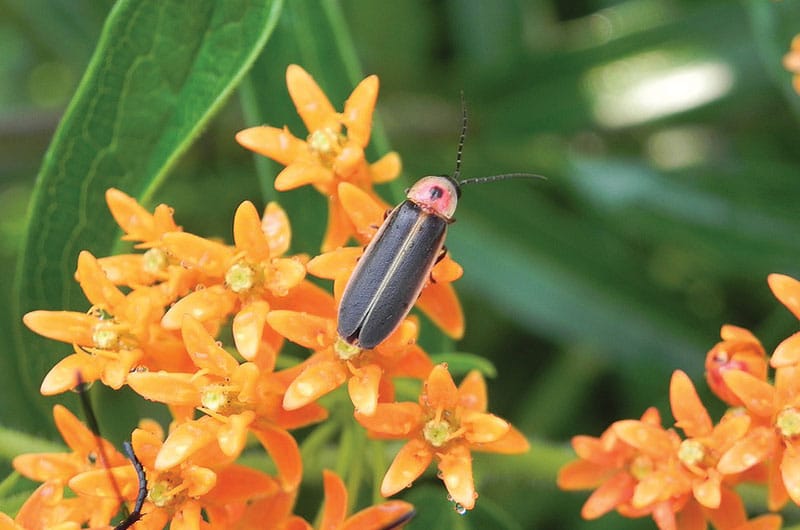by Dr. Sarah Treanor Bois, PhD
Director of Research & Education at the Linda Loring Nature Foundation
Early last week on one of the warmer June evenings, I was in my backyard watering the garden. As the hose sprayed my small raised bed full of hope (I am a terrible gardener) I noticed a flash in the grassland behind our house. To my surprise, it was a firefly – the first of the season for me. During the week since then, I have been ruminating on how early this seems to me. I don’t typically notice fireflies until mid-summer during backyard BBQs, definitely post-July 4th. But, as we know, one observation isn’t that much data, so I looked into it a little more.
First of all, we’ve had some wet weeks this June. The past month weather has been lovely with some pretty nice days. A few people even went to the beach! But there have also been thunderstorms and intermittent rain events. Why does that matter? Fireflies, or lightning bugs, prefer moist, warm soil. Firefly larvae feed on snails, slugs, and pill bugs which are brought out by rains. The damper the soil, the more plentiful the food source will be, and the more food young fireflies will have to carry them into adulthood. It’s the adult fireflies that light up the evenings. The same conditions, namely moisture and warm temperatures that create fog, are also great for fireflies. Nantucket Island should be their favorite place!
I checked out my favorite biodiversity database (iNaturalist) and found that there have been many observation of fireflies on the Cape and Islands during the past few weeks. There were even some sightings back in late May!
Fireflies are actually bioluminescent beetles rather than true bugs. You can read more about firefly basics at yesterdaysisland.com/join-the-firefly-watch/ from that article:
Fireflies and lightning bugs are common names for a family of beetles called Lampyridae. There are actually more than 150 species of fireflies in North America, and more than 2,000 worldwide. They generally divide into three groups based on how they attract mates. There are those that blink in quick flashes, those with long, slow glows, and those that don’t use light at all, but communicate by other means such as pheromones (chemical signals).
We may continue to see fireflies earlier and earlier in the coming decade. A warming climate leads to fireflies, along with many other insects, appearing earlier in the year than was previously normal. Fireflies and many other insects are especially good indicators of regional climate change because they are so in sync with their environment. A 2016 study looked at how climate change can affect firefly populations. The study revealed that the warmer springs predicted by climate change would mean an earlier firefly peak, but only if rainfall remains the same.
Weather not only plays a role in how soon you’ll see lightning bug flashes but how many flashes, too. On warm and humid evenings, it’ll be like a firefly disco party with lots of flashes. Conversely, on cooler nights when air temperatures take a dip into the 50s, it may take longer to see even a single flash. Why is this? Fireflies, like most insects, are cold-blooded (they depend on heat from their surrounding environment to help them function), so their activity peaks when temperatures rise and slows when temperatures drop.
After seeing declines in firefly numbers several years ago, the past few years have seen increases in populations throughout the northeast. Combinations of weather and more people looking and recording may be one explanation. Even if some areas have seen more beetles in their light shows, many areas globally are recording decreases in firefly abundance and disappearances for some populations.
In addition to changes seen with climate change, other factors play a role in potential population declines in certain areas. Dr. Sara Lewis from Tufts University and colleagues published a 2020 paper which was the first systematic review of threats to fireflies. First, habitat loss due to development and agricultural turnover mean fewer places for fireflies to survive. Fireflies need marshes and meadows to live in and illuminate. Adults often cannot fly far—and in some species may not fly at all—so they struggle to move if their habitat is threatened. Many species also have specialized diets, so they can starve if their food supply is lost.
Bioluminescent species (including fireflies) that communicate via glowing lures, warning signals, or courtship advertisements may have their signals obscured by artificial lights, unless the added light is spectrally tuned to reduce its impact. Fireflies need darkness to light up and find love, because bioluminescence is needed for reproduction. Males attract mates with their glowing butts. They need darkness to signal each other. Research with the USDA has shown that broad‐spectrum white light inhibits the production of courtship advertisements by male firefly beetles. Dark skies are diminishing especially in highly populated areas in the northeast. Nantucket’s dark skies initiative, Nantucket Lights, works to preserve our dark nights. We may be seeing more fireflies on-island because of these efforts, but this may be one of the few refuges.
The use of broad-spectrum pesticides also creates challenges for the glowing insects. That’s because adults only survive for a few weeks, just in time to mate. They spend most of their time in the ground as larvae eating slugs and snails before coming out of the ground and lighting up. Pesticides soaking into the ground take a toll.
For those interested in preserving Nantucket’s natural light show, Dr. Lewis has some sound advice. First, she says, “If there’s a place with firefly biodiversity or abundance, try to preserve that habitat.” Not all of us have that ability, but anyone can reduce light pollution. “Turn off your lights during firefly season, or just turn off your lights in general. Have motion-detector lights that only come on when you need them.” And reduce the use of pesticides. This last one would benefit a whole host of beneficial insects.

